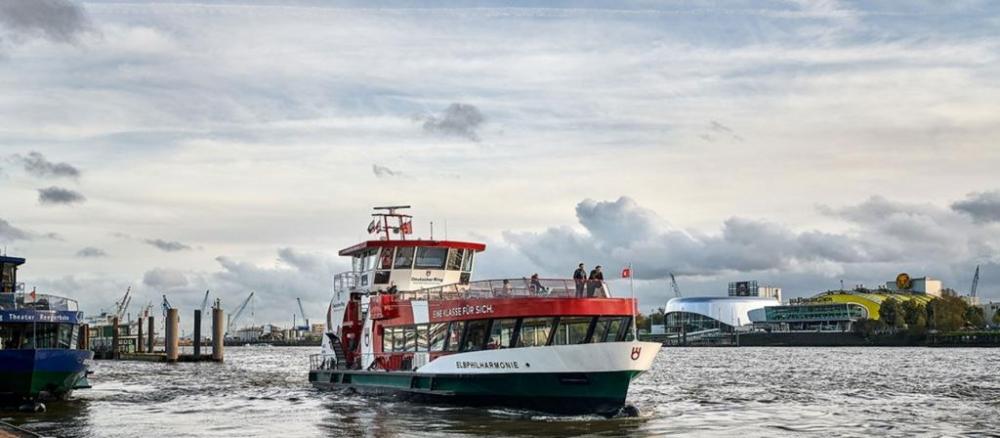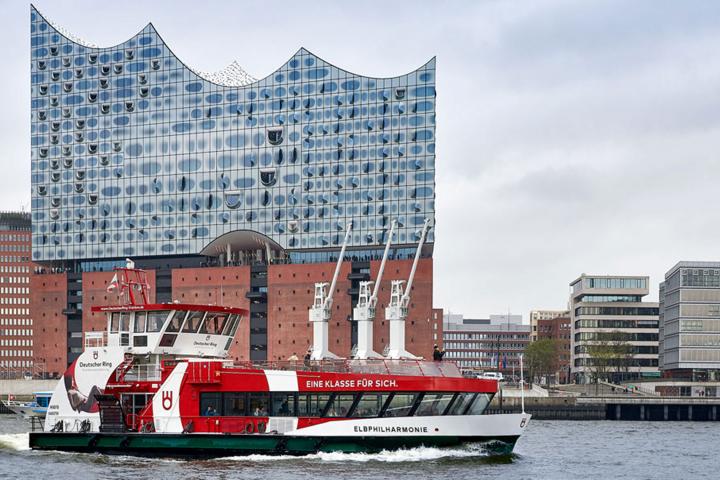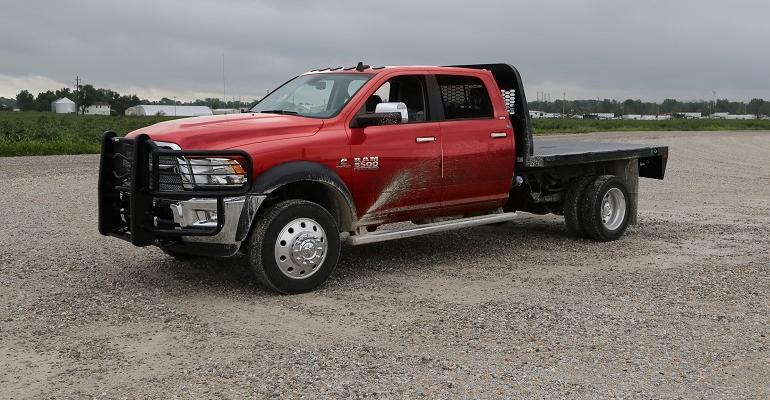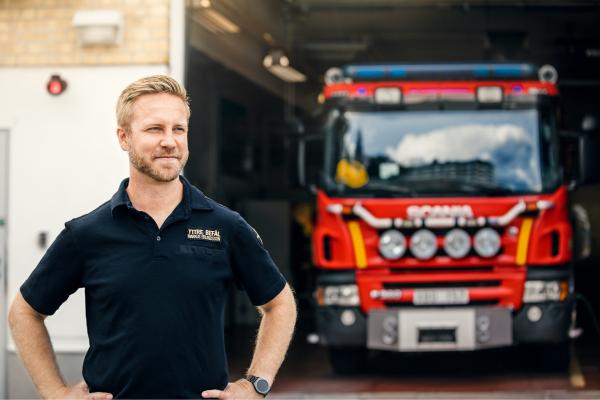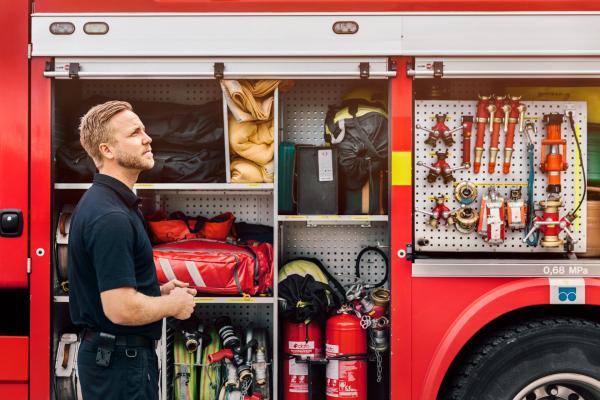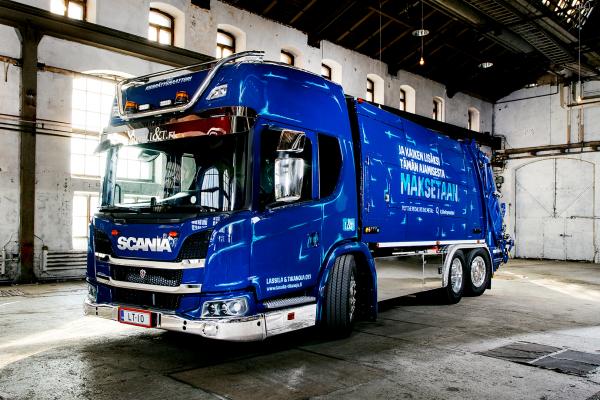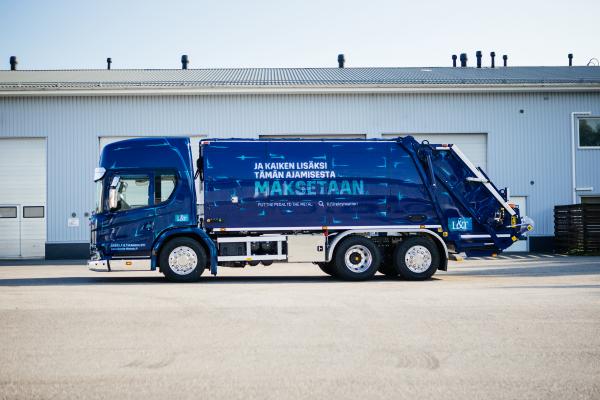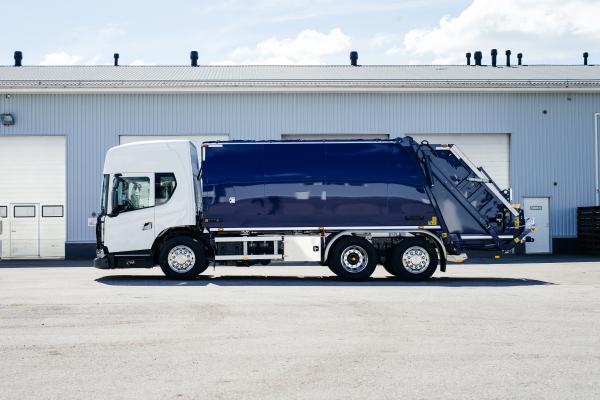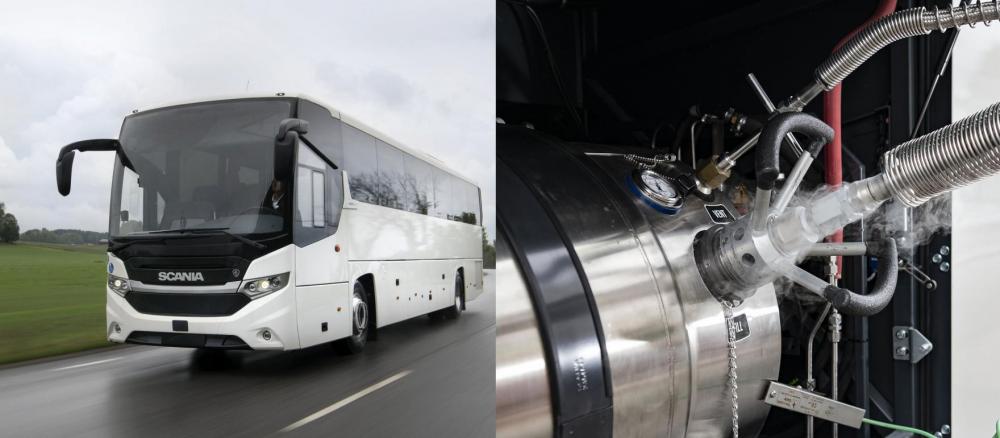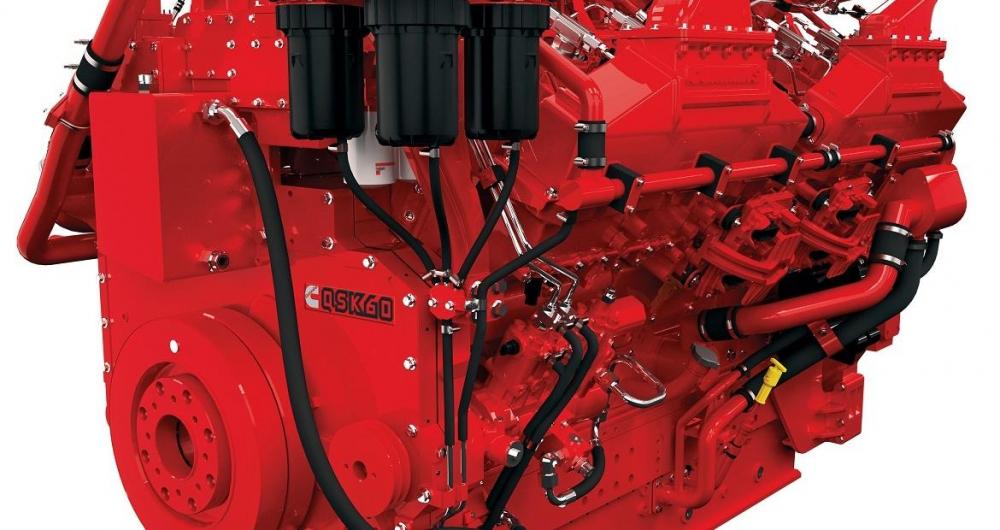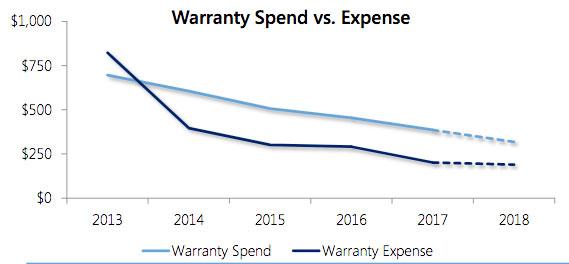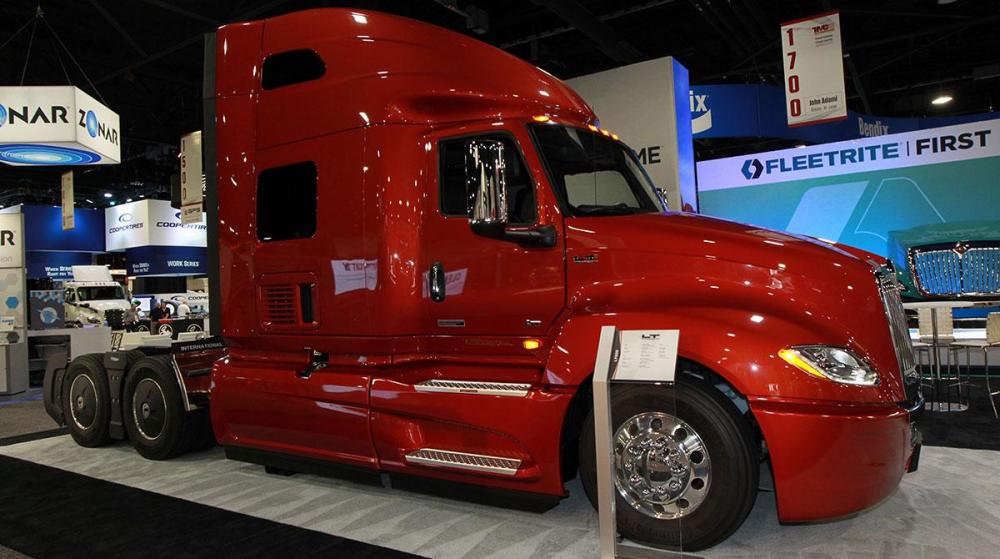
kscarbel2
Moderator-
Posts
18,818 -
Joined
-
Days Won
114
Content Type
Profiles
Forums
Gallery
Events
Blogs
BMT Wiki
Collections
Store
Everything posted by kscarbel2
-
Kenworth Truck Co. Press Release / September 10, 2018 .
-
Scania Group Press Release / September 10, 2018 Bigger and more sophisticated … in Germany we could easily be talking about Hamburg’s famed Elbphilharmonie concert hall. In fact, it’s the hall’s namesake, the Elbphilharmonie ferry, one of the latest vessels to grace the Elbe river as it flows through the city. The Elbphilharmonie, launched in 2017, is operated by HADAG, Hamburg, Germany’s public transport company. The vessel is the prototype of HADAG’s type 2020 and is almost 30 metres long and 8.4 metres wide, making it larger than other ferries in the company’s fleet. Scania 600 hp 13-litre engines With a capacity of 400 passengers, the vessel has 154 seats on the passenger deck and 88 additional seats on the upper deck, and is equipped with two Scania 600 hp 13-litre engines, selected for their reliability and low weight. Floor-to-ceiling windows ensure that passengers get a perfect view of the river and the city, and plenty of space for bicycles and strollers, making the Scania-powered vessel great for a tourist trip or a daily commute. HADAG operates 25 vessels and is responsible for all ferry traffic in Hamburg’s harbour in cooperation with the HVV Transport Alliance. It works across 20 piers and serves more than 8 million passengers a year. .
-
Matt Cole, Commercial Carrier Journal (CCJ) / September 10, 2018 More than 4,000 Freightliner trucks are affected by two separate recalls announced recently by Daimler Trucks North America, according to documents from the National Highway Traffic Safety Administration. One recall, affecting approximately 4,155 vehicles, is for brake caliper mounting bolts that may not have been sufficiently tightened during manufacturing. Loose caliper bolts can reduce the effectiveness of brakes. Truck models included in this recall are: 2018-2019 Freightliner 108SD 2018-2019 Freightliner 114SD 2018-2019 Freightliner 122SD 2018-2019 Freightliner Business Class M2 2018-2019 Freightliner Cascadia 2018-2019 Freightliner Columbia 2018-2019 Freightliner Coronado Only 1 percent of the 4,155 affected trucks are estimated to have the defect. DTNA will begin notifying owners on Oct. 6, and dealers will check and tighten brake caliper mounting bolts for free. Affected truck owners can contact DTNA customer service at 1-800-457-0712 with recall number FL-783. NHTSA’s recall number is 18V-525. The other recall, affecting approximately 116 model year 2018-2019 Freightliner Cascadia tractors, is for pitman arms that may crack and fracture over time, which would cause a loss of steering control. DTNA will begin notifying owners on Oct. 6, and dealers will replace the pitman arms for free. Affected truck owners can contact DTNA customer service at 1-800-457-0712 with recall number FL-784. NHTSA’s recall number is 18V-522.
-
EPA Green-Lights Audit of Controversial Glider Kit Emissions Study Heavy Duty Trucking (HDT) / September 10, 2018 A 2017 study by the U.S. Environmental Protection Agency that found glider trucks emit more greenhouse gases than newer trucks is getting another look. At the request of four Republican congressmen, the Office of Inspector General for the Environmental Protection Agency announced plans to conduct an audit of the agency’s 2017 study of glider kit trucks. Glider kits are a long-standing option for truck buyers that allows a new truck frame and body to be fitted with an older, refurbished powertrain – which has not been required to meet current EPA emissions standards. While glider kits originally were designed to allow truck owners to refurbish wrecked vehicles, in recent years they gained popularity as a way for truck owners to avoid early-generation low-emissions engines that were plagued with maintenance problems and got poorer fuel economy. Opponents of glider kits saw this as a loophole that needed to be closed, and the GHG Phase 2 emissions/fuel economy regulations curtailed their use. Some glider kit makers, including Fitzgerald, challenged the Obama-era rules. Currently the EPA is still evaluating a proposal that would remove the glider kit provisions from the rules. Two different studies have been cited by those on both sides of the issue, and both have come under fire for different reasons. In a Sept. 4 letter to EPA’s Office of Air and Radiation, the Inspector General’s office said it will “examine the selection, acquisition and testing of glider vehicles at EPA’s National Vehicle and Fuel Emissions Laboratory as well as EPA’s planning for this testing.” The audit is in response to questions raised in June by Rep. Greg Gianforte of Montana, chairman of the House Subcommittee on the Interior, Energy and Environment, who questioned the integrity of the EPA glider truck study. Gianforte was joined by three other Republican congressmen, including Reps. Bill Posey of Florida, Steve King of Iowa, and Brian Babin of Texas, who also wrote to the Inspector General requesting an audit of the EPA study. The EPA study has been controversial since it was released last November, just days after the EPA’s administrator at the time, Scott Pruitt, proposed repealing a rule from the Obama Administration that limited the number of nonemission compliant gliders built by a manufacturer to 300 units per year. The rule was included in the EPA’s 2016 Phase 2 greenhouse gas emissions standards for heavy trucks. Pruitt was forced to resign from the EPA in the wake of scandals earlier this year, although the agency is still considering repealing the Obama-era rule limiting the number of annual glider kit production. Adding to the furor is the fact that the Republican lawmakers requesting the audit seem to be suggesting Volvo North America rigged the study to produce an outcome in support of newer, emissions-compliant truck models. The matter is further clouded by a competing study conducted by Tennessee Tech University and funded by Tennessee-based glider manufacturer Fitzgerald Gliders, which found that newer trucks “in some instances” emitted more harmful emissions into the air than glider kits. The Trump-era EPA has cited this study as a reason for rolling back the Obama-era standards limiting glider kit production. However, Tennessee Tech’s own faculty senate has condemned the study as biased. The school’s president, Phil Oldham, said last February that the school would launch an investigation into how the Fitzgerald-funded study was conducted to ensure that proper scientific and educational standards were followed. While the EPA currently has no plans to audit the Tennessee Tech glider study’s findings, agency spokesperson Jennifer Kaplan stressed that this audit is not an investigation into allegations of misconduct. In his letter to the EPA Inspector General, Gianforte claimed that EPA employees reached out to Volvo — which opposes repealing the glider rule — about obtaining glider kit test vehicles. Volvo agreed to work through its dealer network to obtain at least one glider kit for evaluation purposes. John Mies, manager of corporate communications for Volvo Group North America [and its Mack brand], said in a statement, “Like most of the trucking industry, the Volvo Group for several years now has argued that the improper use of glider kits is bad for the environment and unfair to manufacturers who have invested in the latest environmental controls. All our communication and cooperation with the EPA on this issue has been an entirely appropriate part of a broad trucking industry advocacy effort. We did nothing improper.”
-
Ram launches chassis cab truck for ag market Trailer-Body Builder / September 11, 2018 Ram is celebrating its agricultural bonds with a new edition designed specifically for America’s farm families. The 2018 Ram Chassis Cab Harvest Edition is an agricultural market-specific truck and is visually distinguished by two limited-availability colors: Case IH Red and New Holland Blue (Brilliant Black and Bright White also available). Ram recently unveiled the new Class 3-5 medium-duty trucks, expected to go on sale in the third quarter of 2018, at the Husker Harvest Days in Grand Island NE. “Addressing a direct request from farmers, Ram is the only manufacturer to offer Chassis Cab commercial trucks in colors that match two of the most popular lines of farm equipment in the nation,” said Jim Morrison, head of Ram Brand, FCA North America. “The Ram Harvest Edition Chassis Cab delivers high capability and gives farming families a way to show their agricultural brand loyalty.” In August 2017, Ram launched 1500, 2500 and 3500 pickup versions of the Harvest Edition. Case IH and New Holland farm tractors and other agricultural equipment are manufactured by subsidiaries of CNH Industrial. CNH Industrial N.V. shares a common ancestry with Fiat Chrysler Automobiles N.V. The Harvest Edition will be available across the Ram 3500 (SRW and DRW), 4500 and 5500 (DRW, 60-inch and 80-inch cab-to-axle lengths) Chassis Cab lineup, in all four-door Crew Cab and two-door Regular Cab configurations. Optional powertrains include 4x4 versions of the 6.4-liter HEMI V-8 or 6.7-liter Cummins Turbo Diesel. Harvest Edition Chassis Cab trucks are loaded with functional features that are designed to work, including large front tow hooks, a transfer-case skid plate, side steps, fog lamps and a rear back-up camera. Ram Harvest Edition Chassis Cab pricing is expected to range from $43,990 or the Ram 3500 to $49,240 for the 5500. .
-
0% emissions. 100% electric. The all-new eCollect
kscarbel2 replied to kscarbel2's topic in Trucking News
LEADING THE CHARGE Dennis Eagle Press Release / September 11, 2018 Back in May this year we attended the IFAT exhibition in Munich, where we had the pleasure of previewing our latest innovation – eCollect – which will be the very first OEM designed all-electric RCV (Refuse Collection Vehicle). Due to go into production in 2019, eCollect will initially be available to customers as a 6x2RS narrow chassis, 19m3 body and automatic split bin lift. Very exciting times ahead for the future of alternative fuelled RCV's. -
Scania Group Press Release / September 7, 2018 The story of how Scania Crewcab transported brave firefighters to save Sweden’s forests. The summer of 2018 was a time when many fire trucks were put to a severe test. The unusually hot weather in Europe caused a severe drought and in July some 50 forest fires were raging all around Sweden. At this time, four fires were said to be especially difficult to deal with. In fact, they were nearly impossible to put out during the extremely hot weather conditions. These forest fires in the region of Dalarna demanded high attention, not only from the local fire brigade but from all over the country. Scania’s fire trucks – the crewcabs – played an important role at the scene. Help from all over the country Markus Erlandsson is Incident Commander and Operations Manager at the Södertörn Fire Protection Association in Södertälje, a fire department whose fleet mainly consists of Scania fire trucks. Erlandsson was asked to assist at several forest fires, among them one in Älvdalen in the northern part of Dalarna. “We always need to be prepared at our own fire department, but we are more than willing to help out in other cities when our aid is needed,” he says. That’s the case for every municipality. At this stage of the fires, the resources of the fire brigades in Mora and Älvdalen were long gone. The extent of the blazes called for an extraordinary effort. As Incident Commander and Operations Manager, Erlandsson is stationed with the control centre behind the units at the front. The control centre gives the firefighters in the forest directions and decides on what actions to take, depending on wind direction. The part Erlandsson is playing is dependent on how the fire develops. “Sometimes the need for analytics are great, other times you need a logistics person,” he explains. Different tasks at different fires The tasks of the fire trucks differ according to the extent of the fire. A small fire on the ground, maybe caused by a cigarette butt and covering 10 square metres is easily extinguished by the fire truck. At a large forest fire the size of a football field covering up to several thousand acres, the fire trucks play a different role. “We trust the fire truck to take us where we want to go, which is as close to the fire as possible. But often we need to park it and use other vehicles,” says Erlandsson. Forest fires of this summer’s magnitude demand four-wheel drive and tracked vehicles that are suitable for driving in difficult terrain. The fire trucks on the other hand serve as transport to get the firefighters in place as soon as possible. The tanker truck runs like a shuttle service. “Normally we’ll take water from lakes using pumps. Where there’s navigable roads, tanker trucks are also a good option,” says Erlandsson. But in the event of a forest fire close to Stockholm, the conditions are totally different. Here, you can use a road network that doesn’t compare with the much more challenging routes that there are in the more rural areas. Not quite enough The forest fire in Älvdalen was thirty kilometres in circumference. At times, the firefighters were forced to carry many kilometres of fire hose through the forest. The equipment of the fire truck consists of a couple of hundred meters of fire hose. The rest are kept in trailers, owned by each fire department. “For those big fires that I’ve been working at, these are just not enough,” says Erlandsson. Instead, the firefighters used equipment supplied by Swedish Civil Contingencies Agency, that is stored in containers around the country. It is a must to combine the fire-fighting on the ground with airborne water bombing so as to maintain control of the forest fires. Could drones help firefighters in their job? To get an overview at such a massive area is both time consuming and at times even impossible unless you have access to a helicopter. Erlandsson says that it would be a dream to have a drone attached to each fire truck. If so, the firefighters would be able to perceive the extent of the fire much more quickly. But at least Erlandsson and his team have some reliable equipment to help them in their brave mission. And when it comes to the Scania trucks, he confirms that smaller fires are when they are at its best. “Then we can use their full potential and capacity,” he says. .
-
Scania Group Press Release / September 6, 2018 Customised Scania L-series truck being used as driver recruitment tool. Finnish waste and recycling specialist Lassila & Tikanoja has just taken this stunning refuse collection truck into service. In addition to hand-painted details, the Scania L-series truck features several eye-catching customisations, such as stainless-steel bumpers. With hundreds of trucks in waste collection operations throughout Finland, Lassila & Tikanoja (L&T) is always looking for more drivers. The idea behind the ‘Kierrätysnaattori’ — ‘The Waste Terminator’ in English — was to increase interest in the company, which employs approximately 8,000 people in Finland, helping them in their driver recruitment efforts. Wanted: an army of truck drivers The Kierrätysnaattori made its first appearance at the Finnish Power Truck Show in August, where it received an honorary award. “We’ve recently been especially focused on military garrisons since many of the young male conscripts obtain a truck driving licence during their training. We hope that they will start driving for us after national service,” says L&T’s Communications Specialist Terhi Leiniö. To that end, we’ve been present with our truck and representatives at several sports events for conscripts in Finland.” Clearing ‘customs’ in record time The customisation was carried out by Karhuline Truck Customs, operated by Jani Paukku and his wife Tiina Karhula. “We did most of the work on the truck ourselves but since we only had four to five weeks in which to complete it, we had to outsource some parts,” says Paukku. The truck was delivered to their workshop near Lahti with the compactor loader already installed and painted in L&T’s signature blue. “The cab was white and the colours have to match, which wasn’t simple. Other than that, we were given a free rein. My idea from the beginning was that the truck should look both old and modern at the same time,” the customiser explains. “Beautiful” garbage The couple raced against the clock to deliver the truck in time and Paukku admits that he was uncertain of the end result. “I had to trust my instinct and when I saw the finished product it was actually better than I expected, especially considering the short time that was available to us to work on it.” The customer, L&T is also pleased with their new Scania truck: “For me, this is the most beautiful truck in the world!” exclaims Leiniö. .
-
Scania Group Press Release / September 7, 2018 With nearly a half century between them, it might not be a fair comparison to put the Scania 140 up against a brand new Scania S 730. Though we thought it'd be fun to do it anyway. We invited four veteran Scania drivers to the Scania Demo Centre in Södertälje, Sweden, where they got to drive and compare the two trucks head to head. .
-
Scania Group Press Release / September 5, 2018 At IAA, Scania premiers its new Scania "Interlink" Medium Decker coach for liquefied gas (LNG) operations for a range of up to 1,000 kilometres. Scania hereby extends the broad range of alternative fuel options to sustainable intercity coach journeys. “Whereas there are several options for carbon-conscious city and suburban bus operators, there have been fewer alternatives in long-distance travel market that we are now addressing,” says Karin Rådström, Head of Buses and Coaches at Scania. “As LNG is becoming increasingly available throughout Europe, as well as in many other parts of the world, this is a timely and viable alternative.” LNG operations have the potential to reduce CO2 emissions by 20 percent while also substantially reducing nitrogen oxide and particulate matter emissions. Additionally, noise levels are significantly lower. Some countries are also now starting to offer liquified biogas, cutting carbon emissions by 90 percent. Sustainability is Scania’s guiding theme at IAA and the entire bus and coach line-up is operated on alternative fuels – from the Scania "Citywide" LE Suburban hybrid to the Scania "Interlink" High Decker for Hydrotreated Vegetable Oil (HVO). Additionally, Scania showcases its battery electric "Citywide" Low Floor bus, which is presently in regular traffic in the northern Swedish city of Östersund. At IAA, visitors will have the opportunity to experience the bus first-hand on an internal route in the Deutsche Messe trade fair area. .
-
FYI - The Raptor variant of the global Ford Ranger will not be sold in North America. . . . . .
-
Volvo Trucks North America (VTNA) / September 5, 2018 .
-
Peterbilt Motors Co. Press Release / August 31, 2018 .
-
Kenworth Truck Co. Press Release / August 30, 2018 .
-
Cummins Inc. Press Release / September 7, 2018 Cummins will be showcasing its latest QSK60 engine and demonstrating its power portfolio for the global rail market at this year’s InnoTrans in Berlin, Germany (September 18-21) in hall 18, stand 207. Cummins Inc. (NYSE: CMI) will be showcasing its latest QSK60 engine and demonstrating its power portfolio for the global rail market at this year’s InnoTrans in Berlin, Germany (September 18-21) in hall 18, stand 207. Featured at the stand will be the Cummins QSK60 diesel engine, the newest evolution of the Cummins QSK60 locomotive engine design, which will power Stadler’s new state-of-the-art ultra-lightweight South American Light Loco (SALi) locomotives. Designed specifically for the Bolivian Ferrovaria Andina (Andean Railway) FCA, the 60 litre compliant engine combines high-power output with outstanding reliability, allowing the diesel-electric SALi to operate up to 100 km/h on meter-gauge rail networks in harsh environments and at altitudes of over 5,000 meters above sea-level. The QSK60, which can be configured for a variety of emissions standards ranging from non-certified and optimized for fuel consumption to Tier 4 Final, is one of Cummins’ high speed, high performance, and fuel efficient low-maintenance locomotive diesel engines. This includes the QSK78, which powered the longest and largest Australian grain train on record, and the Tier 4 QST30 widely used for passenger locomotives. The Cummins portfolio ranges from 15 litre 650hp QSX15 to its 95 litre 4,400hp QSK95. Regina Barringer, General Manager for Cummins Rail and Defense, said: “For over 70 years, Cummins has delivered innovative rail engines that deliver superior value and reliability. Our work with Stadler on its SALi locomotive demonstrates Cummins global capability in the rail industry. We are providing engine installation support to a manufacturer based in Switzerland, plus the service support for the loco operating in South America. Cummins is the go-to power solutions provider when locomotive manufacturers and operators demand a machine that can not only deliver high performance, but operate in the most testing of environments and duty cycles. Our power portfolio offers engines for all emissions standards and the most niche applications, whilst always providing operators with major reductions in the total life cycle costs.” The QSK60 being showcased at InnoTrans offers a versatile base configuration which means the engine can be used for a diverse range of applications and environments. Utilizing features including a High Pressure Injection (HPI) fuel system and a Modular Common Rail Fuel System (MCRS), the base engine can be designed to match emissions needs or fuel quality concerns, as well as the demands of altitude. It delivers greater fuel economy, lower running costs and outstanding reliability with a peak power output of 3000hp. Alongside the QSK60, the FleetguardFIT from Cummins Filtration will be on display. The FleetguardFIT is the first complete real-time filtration monitoring system that provides customers full visibility to filter life and oil quality through the use of intelligent sensing and advanced data analytics to reduce downtime. The complete FleetguardFIT system contains hardware capable of monitoring differential pressures across stage 1 fuel, stage 2 fuel, lube, up to 6 air cleaners and the overall quality of the lube oil. A subscription portal and a mobile app are also available for equipment condition data reports that are actively monitored for you. The ability to completely monitor filter performance in real time allows equipment owners, maintenance personnel, and end users to tailor service intervals based on true equipment usage and remaining filter life, improving the total cost of ownership. .
-
Jay Leno's Garage - 1953 Firebird I and 1958 Firebird III
kscarbel2 replied to kscarbel2's topic in Odds and Ends
Before People Knew What Autonomous Driving Was, There Was the Firebird Concept “We’re generally trying something right at the limit of what could be done.’ Norman James, retired General Motors designer Motivated by the space race, a generation of General Motors employees created the revolutionary Firebird series of concept cars. Today, GM continues to challenge expectations of what can be achieved. At General Motors, we’re pushing the boundaries of what’s possible, helping to lead the way in electric and autonomous vehicles. Its cutting-edge technology, but our exploration into self-driving automobiles started long ago, with the 1950’s series of Firebird concept cars. Although they might be distant cousins to today’s advanced vehicles, our passion, imagination and drive to transform the future of mobility is as strong as ever. Video - https://www.gm.com/our-stories/commitment/before-people-knew-autonomous-there-was-firebird-concept.html -
I would have thought your KATO to have a Mitsubishi engine. Is this your crane? http://www.graysonline.com/lot/0010-3001816/transport-trucks-and-trailers/mobile-crane-kato-nk-200-20-ton-capacity#
-
Trump threatens tariffs on additional $267 billion in China imports Steve Holland, Reuters / September 7, 2018 WASHINGTON -- U.S. President Donald Trump said on Friday that he has tariffs ready to go on a further $267 billion worth of Chinese imports, as the world awaits his decision on imposing levies on $200 billion worth of the Asian nation's goods. “The $200 billion we are talking about could take place very soon depending on what happens with them. To a certain extent its going to be up to China, Trump said. "And I hate to say this, but behind that is another $267 billion ready to go on short notice if I want. That changes the equation.” Hours after a public comment period closed on his $200 billion China tariff list, Trump told reporters aboard Air Force One that he was "being strong on China because I have to be." Trump also said on Friday the United States and Japan have begun discussion over trade, saying that Tokyo "knows it's a big problem" if an agreement cannot be reached. "We're starting that," Trump told reporters aboard Air Force One. "In fact Japan has called us ... they came last week." "If we don't make a deal with Japan, Japan knows it's a big problem," he added. Trump, who is already challenging China, Mexico, Canada and the European Union on trade issues, has expressed displeasure about his country's large trade deficit with Japan, but had not asked Tokyo to take specific steps to address the imbalance. On Thursday, though, CNBC reported he had told a Wall Street Journal columnist he might take on trade issues with Japan, causing the dollar to slip against the yen. More on China Trump has already imposed 25 percent tariffs on $50 billion worth of Chinese goods, mostly industrial machinery and intermediate electronics parts, including semiconductors. The $200 billion list, which includes some consumer products such as cameras and recording devices, luggage, handbags, tires and vacuum cleaners, would be subject to tariffs of 10 percent to 25 percent. Cell phones, the biggest U.S. import from China, have so far been spared, but would be engulfed if Trump activates the $267 billion tariff list. Trump's threatened tariffs, now totaling $517 billion in Chinese goods, would exceed the $505 billion in goods imported from China last year. But 2018 Chinese imports through July were up nearly 9 percent over the same period of 2017, according to U.S. Census Bureau data. Earlier on Friday, White House economic adviser Larry Kudlow told Bloomberg Television the administration would evaluate public comments before making decisions on the $200 billion tariff list. The U.S. Trade Representative's office received nearly 6,000 comments and held seven days of public hearings on the proposed levies. Most comments were from companies seeking to remove products from the tariff list, arguing there were few, if any alternative sources and the duties would cause financial hardship. Comparatively few applauded the tariffs. Retailers had successfully kept high-profile consumer electronics such as cell phones and television sets off of previous tariff lists. But David French, top lobbyist for the National Retail Federation, whose members include Amazon.com, BJ’s Wholesale Club and Macy’s, said nearly every consumer good could be affected if Trump follows through on all threatened tariffs. "The Chinese aren't paying these tariffs, American families are going to pay these tariffs. These are taxes and they're going to find their way into the pocket book of folks around the country," French said. Still talking to China Kudlow, who heads the National Economic Council, told CNBC the administration was still talking with China about trade issues but so far China had not met U.S. requests. The United States has demanded that China better protect American intellectual property, cut its U.S. trade surplus, allow U.S. companies greater access to its markets and roll back its high-technology industrial subsidy programs. "We are still talking with China on a number of issues ... Those talks will continue to go on. We want lower (trade) barriers across the board," Kudlow said. Specifically, Kudlow said, the United States was seeking "zero tariffs, zero non-tariff barriers, zero subsidies, stop the IP theft, stop the technology transfer, allow Americans to own their own companies." "Those have been our asks for many months and so far those asks have not been satisfied," he said. "However, hope springs eternal."
-
Navistar Bullish on Truck Market as it Reports Strong Third-Quarter Results Deborah Lockridge, Heavy Duty Trucking (HDT) / September 6, 2018 Navistar is bullish on the trucking industry and its own growth, as truck orders appear to show no signs of slowing and the company reports its Class 8 market share is up 2.7 points over a year ago while its 13L heavy engine share more than doubled. In its third-quarter 2018 earnings call on Sept. 6, Navistar reported higher revenues, led by a 25% increase in its truck segment for its fiscal quarter ending July 31. Net income rose to $170 million, up from $37 million a year ago. Profit in the truck segment alone rose to $165 million, from $7 million a year ago. Navistar is predicting that Class 8 truck sales industry-wide will end 2018 between 260,000 and 280,000, and projects 2019 to be about the same, in the 255,000-285,000 range. That compares to 207,000 in 2017. For Class 6/7 medium, Navistar is projecting sales of 95,000 for this year and next, up from 86,000 in 2017. Troy Clarke, Navistar chairman, president and CEO, pointed out that economic conditions are ripe for industry growth, with GDP expansion of 4.1% the strongest since 2014, July consumer confidence the highest since 2000, and the purchase manager’s index on manufacturing the highest since 2004. “These conditions support fleet utilization, higher freight rates, and improved carrier profits,” he told investor analysts and reporters in the call. “It’s just a great time to be in the truck business.” For the quarter ending July 31, Navistar officials said, its retail market share in the U.S. and Canada for Class 8 heavy trucks was 13%, up from 10% a year ago. Number for medium-duty Class 6/7 were down from 25% to 22%, but officials pointed out that the new MV model for that market, announced in the spring, only started taking orders in July, so it expects that metric to improve. Clarke also pointed to record industry-wide July Class 8 truck orders of more than 52,000, and said there are industry backlogs into the second quarter of 2019. Some skeptics, he said, are questioning whether these all will actually be built, or if some are placeholders for fleets wanting to make sure they will have build slots, or stock unit orders for dealers. “These are all good questions,” he said. “At Navistar we attempt to manage reporting of orders as accurately as possible, and we don’t expect a lot of cancellations.” With the increasing popularity of the new International LT on-highway tractor, and July being the first month of orders for the new medium-duty MV, Clarke said, “we took in a lot of orders in Q3, July in particular, but cancellations have remained very stable for the last 18 months. We expect to build the units in our backlog.” Most of the orders continue to be for replacement trucks, Clarke said, as new models get much better fuel economy than the four- or five-year-old trucks they are replacing. But he’s also seeing an increasing number for fleet expansion, even in the face of a driver shortage. “There is a piece of that reflecting fleet expansion, reflecting GDP growth and a shift in mode toward more dedicated transport, which at the end of the day requires more trucks and fleet growth.” He expects to see more of that starting this fall. “I think as we roll in to our fiscal 2019, we will see fleet expansion for a handful of reasons. To me that’s the best environment had in the eight years I’ve worked here.” Production during the third quarter was hampered by supplier constraints, but company officials said they have worked through many of those issues and now face a delivery backlog. These supplier disruptions resulted in units not produced, or trucks that were built but not shipped because they were still awaiting a part, Clarke explained. As it increased build rates, the company had to work with a handful of suppliers to bring more capacity online, resource some work to other suppliers, and improve its productivity. “The issues related to these suppliers are behind us,” he said, but officials are continuing to closely monitor the overall supply chain for components and parts, which remains tight for the industry. “The industry is basically running without buffers, so things like power outages or breakdowns can cause problems,” he said. “But they remain minor in scale and we believe we have realistic view of supplier capacity.” Rising raw materials costs, especially for steel, are so far being offset by hedging, long-term contracts, and cost reductions, especially through Navistar’s joint procurement deal with Traton Group (formerly Volkswagen Truck & Bus). Nevertheless, the company announced a 1% to 3% price increase in July across its brands. Those increases won’t take effect until sometime in 2019 because of the large backlog. Clarke explained that while part of the increase is due to increased material and other costs, it also reflects the improved quality of the product line, which is now entirely new or updated. Navistar continues to make progress on the legacy issues that have dogged it. Warranty expense for the quarter (excluding pre-existing claims) as a percentage of revenue was 1.7%, down from 2.4% a year earlier. It still has some 1,100 of the MaxxForce 13 engines in inventory, but that’s down from last year. Revenues were up in Navistar’s parts business compared to a year earlier, although net profit was down. The company saw double-digit growth in its Fleetrite branded all-makes components, as it shifts its revenue mix in the parts business to more private-label brand sales. Navistar’s global operations saw a slight increase in revenue and profit, as economic conditions have improved in Brazil, while the financial services business profits were about the same on slightly higher revenue. .
- 1 reply
-
- 1
-

-
Jason Cannon, Commercial Carrier Journal (CCJ) / September 6, 2018 North American Class 8 truck orders reached 52,400 units last month, another all-time high, according to preliminary figures released by FTR Thursday. Six of the top 12 order months on record have occurred in the first eight months of this year and August’s order intake broke the previous record-high set just a month earlier by 300 trucks. August orders were up 153 percent year-over-year and North American Class 8 orders for the past 12 months have now totaled 477,000 units. “The good news is, it appears the supplier shortage issues that significantly slowed production earlier this year, have been largely abated for now. However, the supply chain remains tight, and fleets and dealers continue to place large orders to lock down build slots in 2019,” says Don Ake, FTR vice president of commercial vehicles. “Fleets are ordering early and often and orders this plentiful indicate fleets are highly confident the flourishing freight market will persist for a while. Current economic and manufacturing data point to a strong start to 2019. FTR does expect some easing to occur in the second half of next year.” Carriers are pressing to get enough trucks on the road to handle freight growth while a booming economy and healthy manufacturing sector are stretching the logistics system to the limit, Ake says. In some markets, goods are moving slower due to supply chain gridlocks, calling for even more trucks to deliver goods, he adds. “Super-strong orders in June and July are likely pulling large fleet orders ahead in the schedule, as truckers race to reserve build slots in a market where demand is running well above capacity,” added another analyst.
-
Roger Gilroy, Transport Topics / September 6, 2018 Navistar International Corp. reported a surge in net income and an 18% increase in revenue for its fiscal year third quarter, citing the market’s enthusiasm for its latest truck and engine products, and expressed confidence that current market conditions would continue into the first half of 2019 — and possibly beyond. For the period ended July 31, net income was $170 million, or $1.71 per diluted share, compared with $37 million, or 38 cents, a year earlier. Revenue in the quarter reached $2.6 billion compared with $2.2 billion in the same period one year ago. “It was a very good, strong quarter, a robust market,” Chairman and CEO Troy Clarke said during a Sept. 6 earnings call. “We are set up for a very strong close to 2018 and a great start to 2019. This is a great time to be in the truck market and it is a great time to be in Navistar.” The company is the parent of International trucks. In the quarter, the truck segment had a profit of $165 million compared with $7 million for the year-ago period. The improvement was primarily driven by the impact of higher volumes in Navistar’s core markets and lower charges related to legacy engine litigation recorded in the third quarter of 2017, according to the Lisle, Ill.-based company. The segment also benefited from the settlement of a business economic claim. The division was negatively impacted by industry supplier constraints that resulted in higher company inventory, lower volumes, cost inefficiencies in the assembly process and additional freight costs — issues the company is now working through. “Parts are now available in sufficient quantities to support production and complete any truck requiring a part,” Clarke said. “Offline inventories have returned to normal and we are working through a delivery backlog of trucks ready to transport to customers and dealers. But the supply chain remains really tight.” He added, “We believe we have a realistic view of supplier capability in our revised guidance.” Based on stronger industry conditions, the company raised its 2018 full-year guidance: industry retail deliveries of Class 6 through Class 8 trucks and buses in the United States and Canada are forecast to be 390,000 to 410,000 units, with Class 8 retail deliveries of 260,000 to 280,000 units. The parts segment’s third-quarter net sales hit $605 million, up $19 million compared with the year-ago quarter amid continued double-digit growth of the Fleetrite brand, partially offset by lower Blue Diamond Parts sales. The parts segment recorded a profit of $144 million, down 8% compared with a year earlier — primarily due to lower proprietary parts sales, higher freight-related expenses and inter-company access fees. Navistar’s financial services segment saw net revenue increase by $3 million to $65 million year-over-year, primarily due to higher average portfolio balances in the United States and Mexico. But its profit of $23 million was comparable to a year earlier. Navistar said overall third-quarter highlights included 2.7% year-over-year growth in Class 8 heavy-duty retail market share — boosted by strong sales of the International LT Series on-highway truck. There was also growth in the engine division; Navistar’s 12.4-liter A26 engine saw its market share more than double from the year ago quarter. The engine is now also available in International’s severe-service vehicles, the HV Series and HX Series. Additionally, the new MV Series contributed to 66% growth in medium-duty orders. The company also announced that as of June all of its new on-highway International trucks will be equipped with the company’s proprietary OnCommand Connection telematics, with two free years of service included. The system integrates a cellular-enabled hardware platform with a range of technology solutions, including telematics and the OnCommand Connection remote diagnostics platform. This is the company’s first telematics product that has additional services that can be purchased or accessed via subscription. In the current pilot stage, fleets have been paying for features such as automated driver inspection, Clarke said. What he called the “original pod” of OCC customers — using the original free service with a handful of basic services — includes 475,000 trucks that the company is monitoring regularly. About two-thirds of those are not International-branded trucks, and one third are, he said. Meanwhile, Clarke said the company needed to invest in getting parts to dealers faster, systems support, electric vehicles and brand new diesel powertrains in conjunction with its alliance with Traton Group, formerly known as Volkswagen Truck & Bus, which owns about 17% of Navistar. “We are going to fund a lot of this through the continuing economies and efficiencies we have been able to generate through investments we have made in [being] a lean enterprise to lower our break-even point,” he said. .
-
Navistar profit beats estimates on higher truck sales Reuters / September 6, 2018 Truck and engine maker Navistar International Corp topped Wall Street’s quarterly profit estimates on Thursday, as hauliers replaced more trucks and strong freight demand boosted vehicle sales. Revenue in its trucks business, its biggest, jumped 25.1 percent to $1.92 billion in the third quarter ended July 31. The Lisle, Illinois-based truck maker raised its fiscal 2018 revenue forecast to between $10.1 billion and $10.4 billion, from between $9.75 billion and $10.25 billion it previously forecast. Navistar, which posted its first full-year profit in six years in 2017, has changed management, cut costs and redesigned its products to recover from a disastrous bet it made on a costly proprietary [EGR] smog-reduction system. The company also raised the low-end of the number of Class 8 trucks it expects to sell in fiscal 2018 to 260,000 units from 250,000, while keeping the high-end at 280,000 units. Orders for Class 8 trucks have been rising every month this year through July. Net income attributable to the company rose to $170 million, from $37 million a year earlier. Earnings per share from continuing operations rose to $1.71 per share from 37 cents per share. Excluding items, the company earned $1 per share, topping analysts’ average estimate of 90 cents, according to Thomson Reuters I/B/E/S. Revenue rose 17.8 percent to $2.61 billion, but missed expectations of $2.66 billion.
BigMackTrucks.com
BigMackTrucks.com is a support forum for antique, classic and modern Mack Trucks! The forum is owned and maintained by Watt's Truck Center, Inc. an independent, full service Mack dealer. The forums are not affiliated with Mack Trucks, Inc.
Our Vendors and Advertisers
Thank you for your support!


